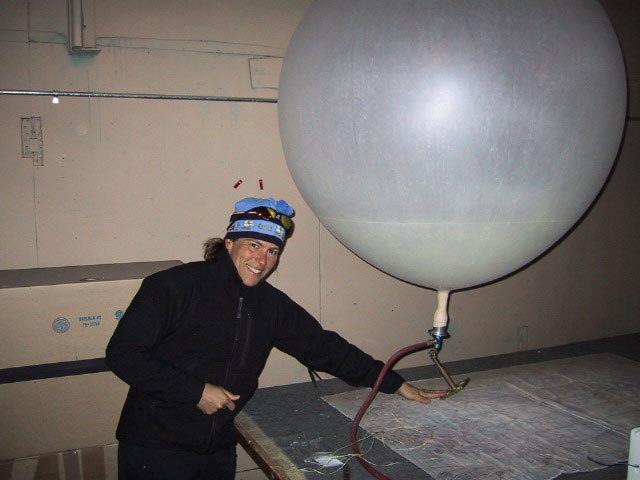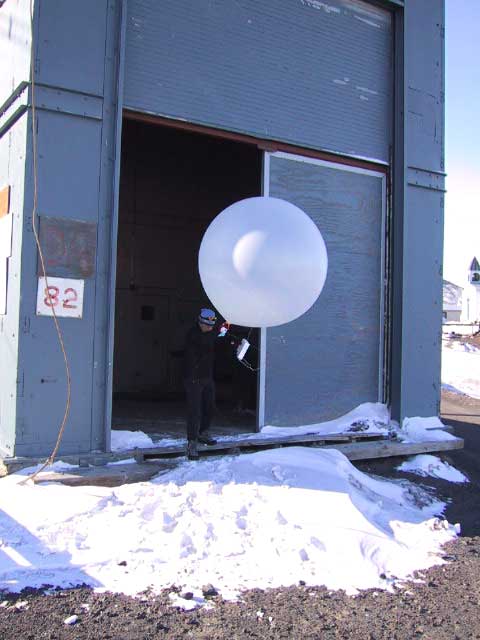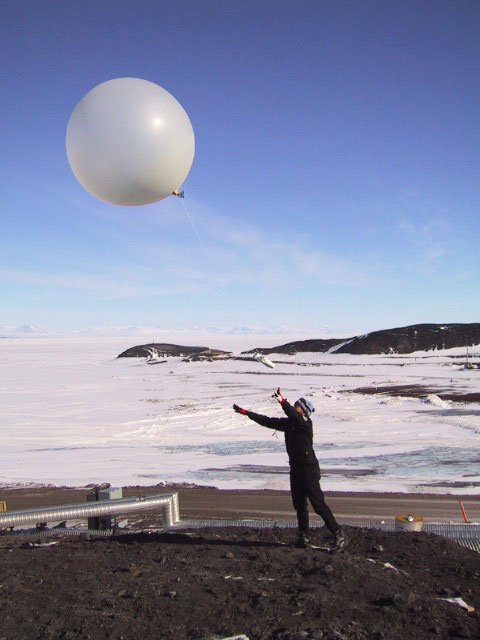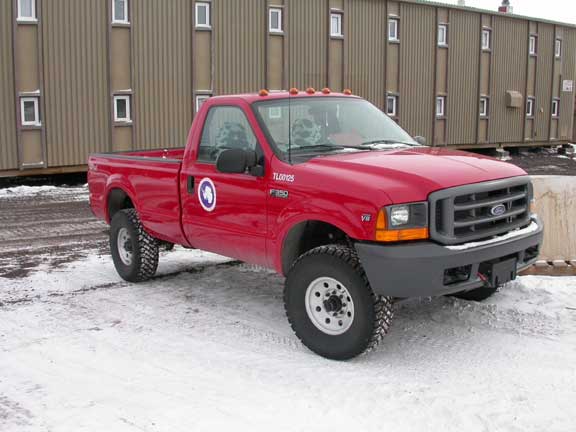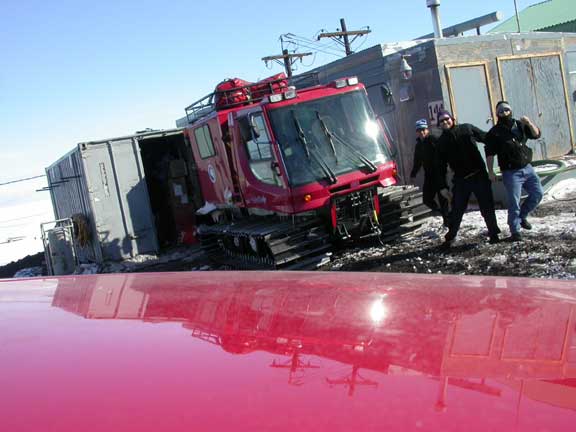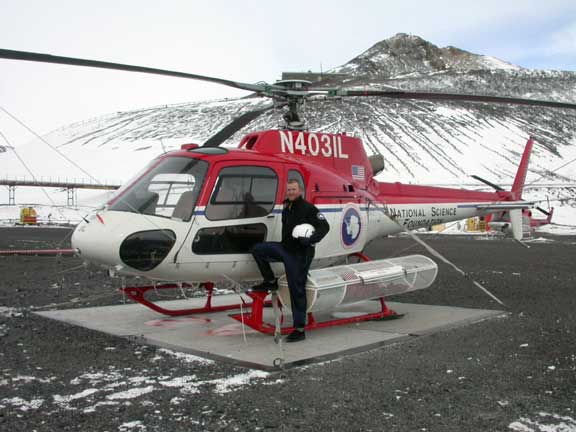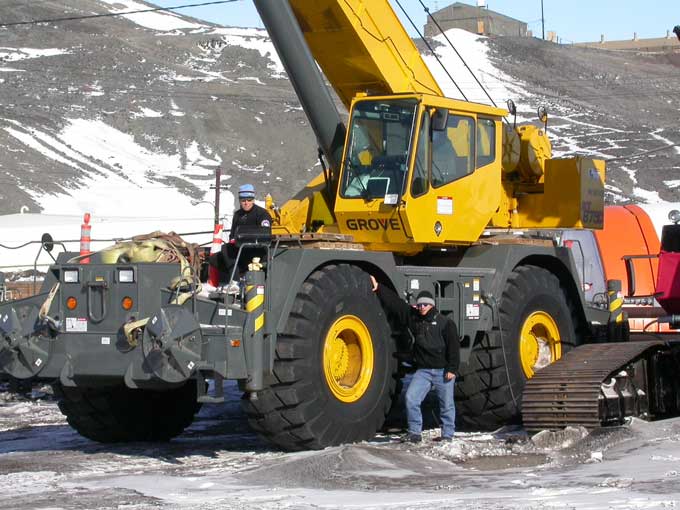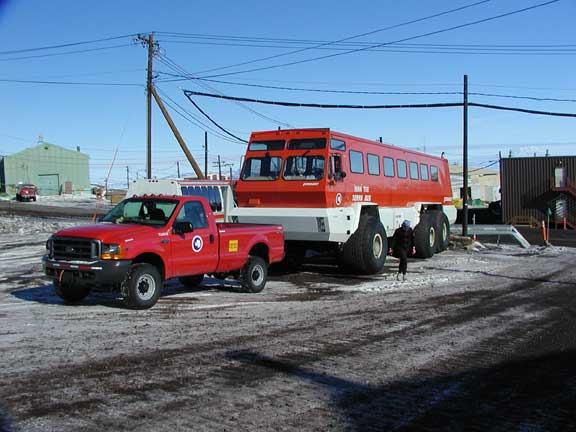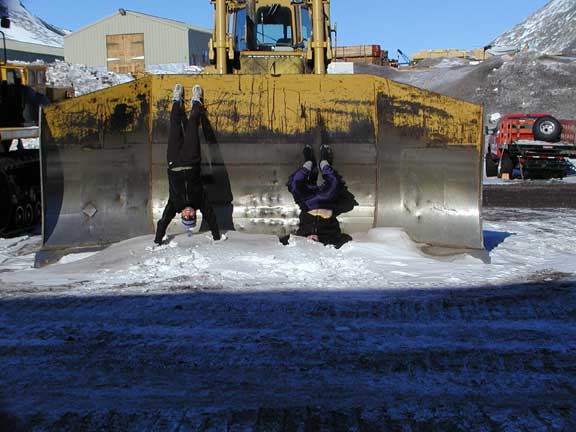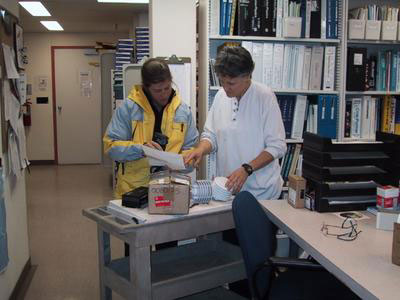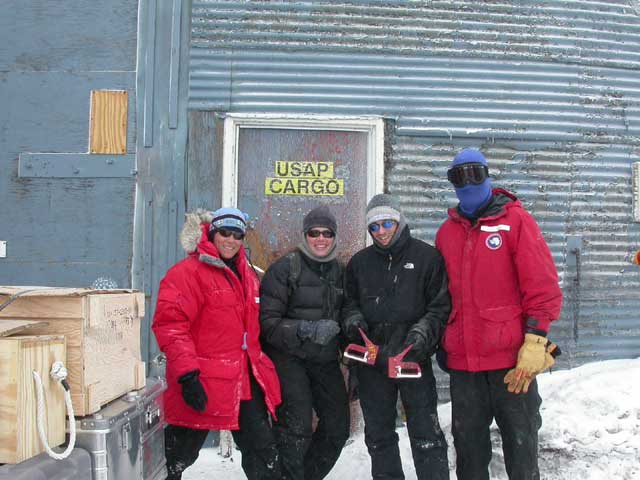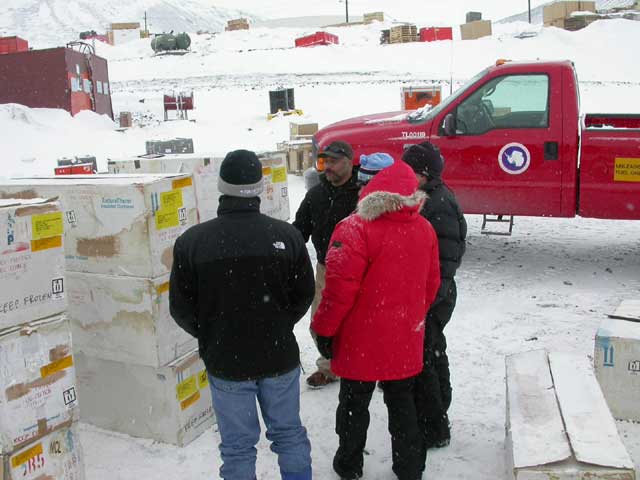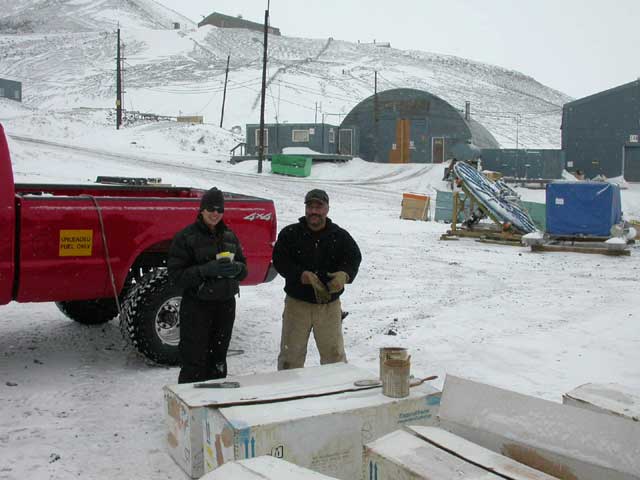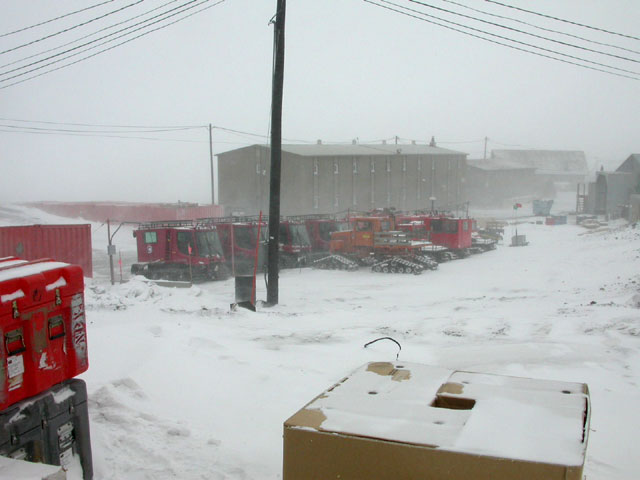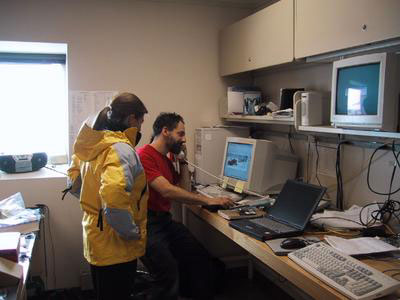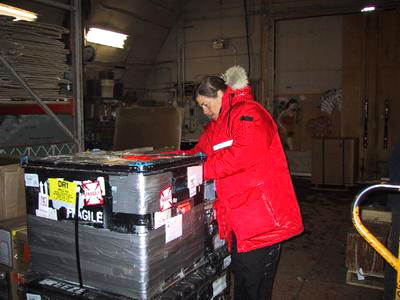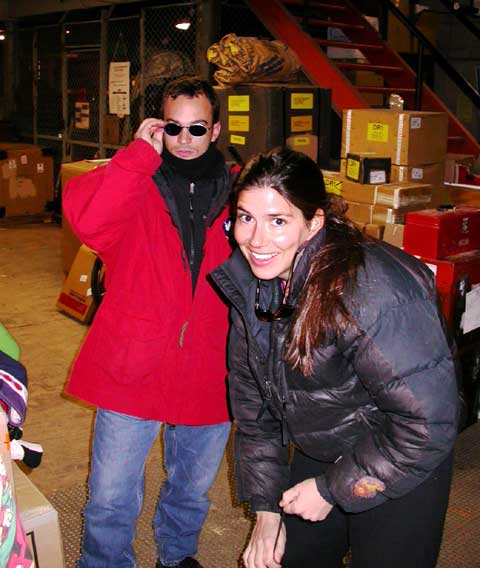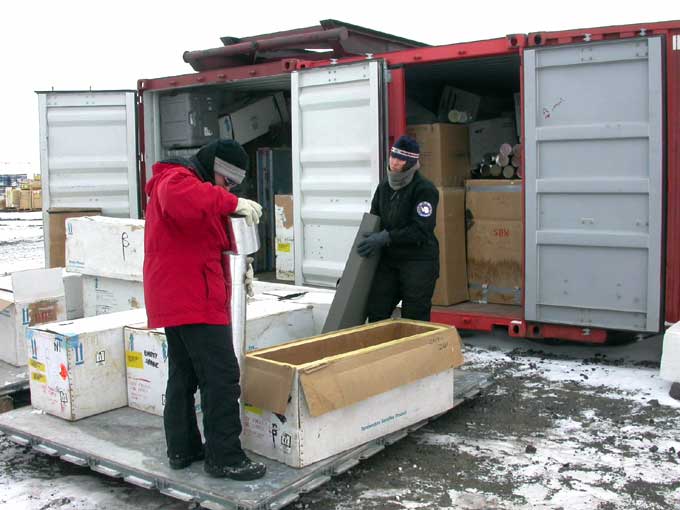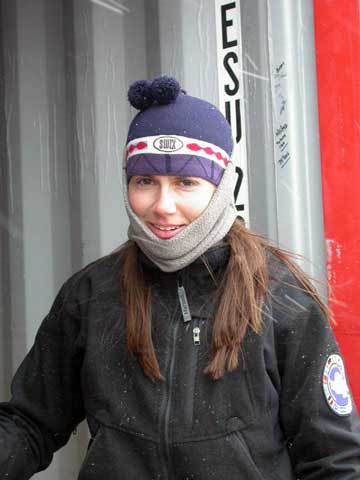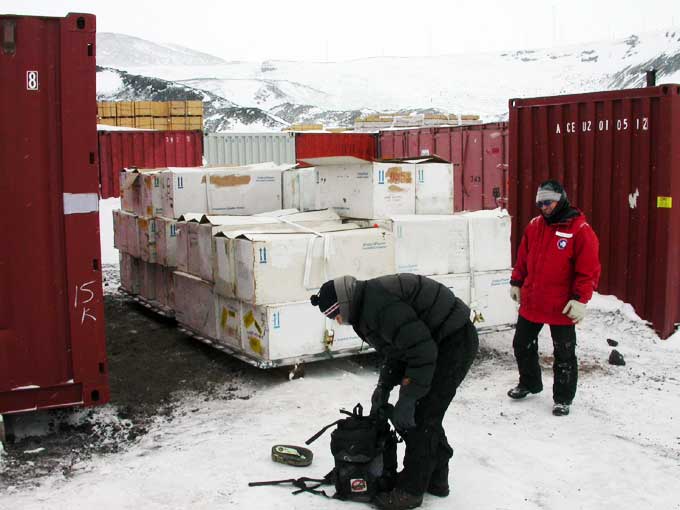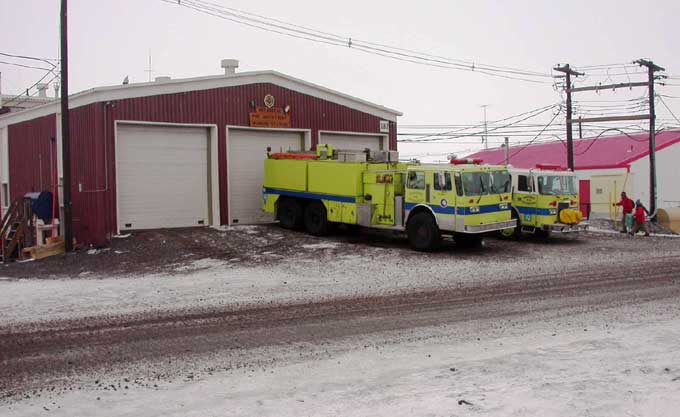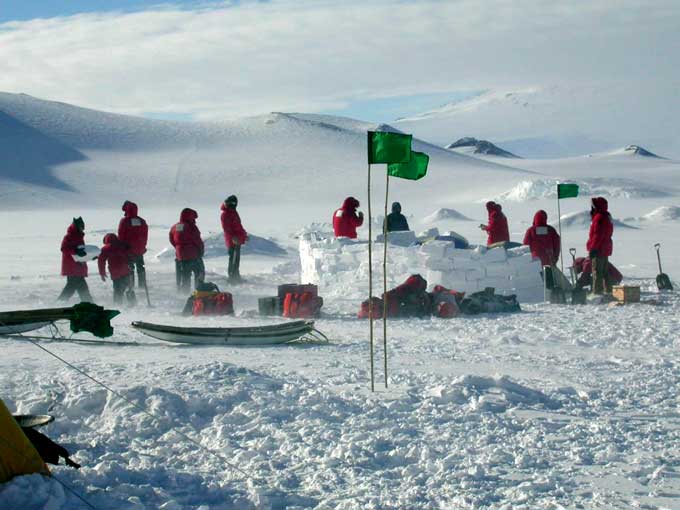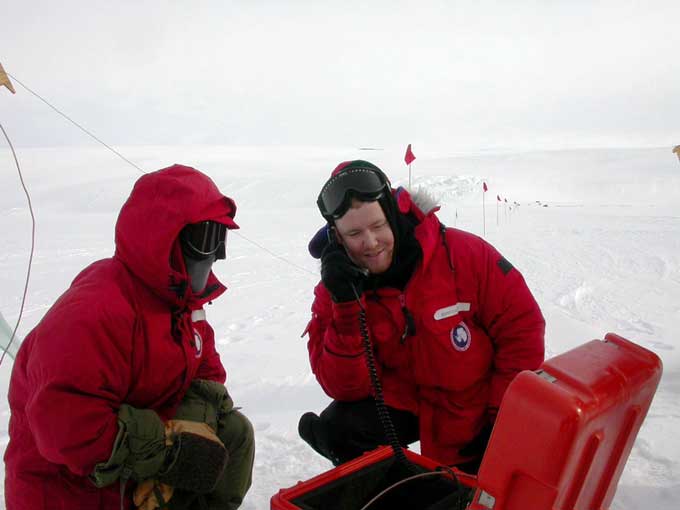
- 1999
- 2000
- 2001
- 2002
- 2003
- 2006
- 2007
Week 2 - November 4th to November 10, 2002
Date: 11/10/02
Latitude: 77 degrees, 51 minutes South
Longitude: 166 degrees 40 minutes East
Temperature: –12°C( 10°F)
Wind speed: 7 knots
Wind Chill: –27°C( –16°F)
Wind direction: Northeast
Meters of ice collected: 0
Notes on daily life:
Thanks to the friendly folks in Mac Weather observations, especially Ted, I have had the chance to practice launching weather observing sondes for the past few days. I met Ted when I was on my scavenger hunt a few days ago. Ted has been doing weather observations since he was 17 years old! He "tells it like he sees it" several times a day here in McMurdo. His observations take place on a rigorous round the clock schedule, coordinated with other weather observers worldwide. These observations are all recorded in a central network. From that network database weather patterns can be tracked and forecasts made. Ted generously allowed me to help with the balloon launch today. I will be launching these same types of balloons in the field, so I am grateful to have more chances to practice my technique in the controlled conditions of McMurdo station.
The process of launching a balloon begins in the office where the receiving units for the radio signals are kept. There we activated the sonde and gave it a chance to begin its communication signals. As soon as the radio beacon and the receiver had located one another, we headed out of the office to attach the signal unit sonde to a large helium balloon for a launch. The balloons are made of latex and are filed in a shed to protect them from the wind. In the field I won't have a shed to work in, so it will be more difficult to control the balloon while filing it.
Once the balloon is filed with helium attached the sonde to it and then took the balloon outside for the launch. Something about holding a balloon in your hand brings out the kids in a person. After I let go of the balloon I felt a pang of sadness as if I had accidentally let go of my balloon at the county fair. I watched the balloon go high into the sky. Ted says that they go as high as thirty thousand feet in about an hour and a half!
Today the weather is glorious! It must be because there was a beach party here last night, so the wind stopped and the skies cleared. Everyone could go out in shorts to get to the party. Many people could be seen shopping in the recycle (skua) bins for pairs of trousers and other garb to wear. Not only is the clearing skies good news for the partiers, but it also means that the rest of our team may be arriving later today. We are definitely looking forward to seeing Paul, Markus, Blue, Brian, Eric, Steve and Gordon.
Date: 11/09/02
Latitude: 77 degrees, 51 minutes South
Longitude: 166 degrees 40 minutes East
Temperature: –7°C( 19°F)
Wind speed: 15 knots
Wind Chill: –35°C( –30°F)
Wind direction: Northwest
Meters of ice collected: 0
Notes on daily life:
Today was not too interesting for the ITASE team. We spent a while sorting and repacking boxes at science cargo and then worked in the Crary Lab for a few hours cutting plastic tubes to put ice cores in. So, we decided to give you a little taste of McMurdo by photographing a number of the weird and unique vehicles that make McMurdo run. Not to mention it provided us the opportunity to finally leave the packing behind and have a little fun. The stalwart vehicle of Mactown is the super duty ford F–350. Back in the states this would be considered an extremely large and capable vehicle but it's the bottom end vehicle on the streets of McMurdo. Figure 1
The Piston Bully looks like a mix between a snowmobile and a delivery truck and is very common in McMurdo. It's a tracked vehicle so it is useful in snowy areas and out on the sea ice. Be wary as our photographic evidence shows they take the name bully quite seriously and will charge when provoked. Figure 2
A Matura is unique vehicle that you won't find at your local Ford dealership. It is an F–350 Super Duty pickup fitted with tracks in place of wheels. It is important to chock vehicles in McMurdo to maximize safety. However we found that undergraduates do not make good impromptu chocks. Figure 3
Forklifts are a ubiquitous presence in Mactown. Nearly all USAP cargo into and out of the continent passes through town so you'll see forklifts of every shape and size prowling the streets. All they really need is a little direction and they can do nearly anything. Figure 4
Helicopters are also a common presence in McMurdo. There are four American and one New Zealand helicopter on station and they are often seen or heard ferrying cargo and science parties to field locations near the Station. Due to some silly regulations and what not the pilots wouldn't let Jim fly; but a picture holding a helmet is almost as cool right? Figure 5
Mac–town also has its fair share of gargantuan construction equipment. These highly specialized items give the USAP the flexibility to make McMurdo into such a large and dynamic base. Dan is seen here realizing that this crane's wheels are themselves large and dynamic. Figure 6
Of course one of the most popular vehicles at the base is Ivan the Terra–Bus. Ivan is used to shuttle new arrivals from the runways to the base and is the first uniquely Antarctic experience that most new arrivals have. In this shot you can see how huge Ivan is as he dwarfs our relatively large super–duty truck. Figure 7
McMurdo Station receives a decent amount of snow and the fierce winds rearrange this into giant drifts. It is essential to have equipment that can move Antarctic sized snow drifts so the base can keep operating smoothly. These vehicles have the added and highly specialized benefit of plowing over scientists who get stuck doing handstands. Figure 8
Well hopefully, you enjoyed our quick tour of McMurdo's "Tonka toys" as much as we did. Science is a discipline that requires a great deal of teamwork and support to accomplish it mission. Often, this equipment is thought of as instruments and glassware in a lab, but in Antarctica the equipment that turns out to be the most important would never be seen in a laboratory. Everything has an important and necessary role and our traverse is just as dependent on forklifts to move our cargo, trucks to transport our team members, and aircraft to transport us as it is on radar and ice core drills that collect our actual data. Documentation is an essential part of scientific research and photographs are a wonderful way to record science in the field. However, one of the major limitations of photography is that depth and size relationships can be lost unless a subject is included for scale. Thankfully the ITASE members were more than willing to fulfill this role in these photos. Hopefully you now have a little better feel of McMurdo Station. We look forward to the arrival of the rest of the team tomorrow so that we can start making our final preparations for the expedition.
Date: 11/08/02
Latitude: 77 degrees, 51 minutes South
Longitude: 166 degrees 40 minutes East
Temperature: –11°C( 12°F)
Wind speed: 35 knots
Wind Chill: –36°C( –33°F)
Wind direction: South
Meters of ice collected: 0
Notes on daily life:
Our major task at this time is preparing our equipment for the field. In order to do this seemingly straightforward task; many people must be involved. For today's journal entry I will take you on a tour of the people and places we have visited while setting up the equipment needed for the collecting ice core and atmospheric data. A day like today can begin to feel like a large scavenger hunt. As I hiked from building to building I enjoyed meeting the many helpful people of McMurdo station. Without their support accomplishing our science objectives would be much more difficult. Here are a few of the people and places we went today in our work.
First the cargo must arrive and be checked in at science cargo. At this stop each piece is given a tracking number that is stored in an enormous database. The science cargo packed in boxes of various shapes and sizes is tracked by weight, cubic area and description. Once the cargo has a tracking number it is stored on the cargo line if it can be frozen or in a warehouse if it needs to be kept warm. We have cargo stored in both areas.
Michael assisted us in finding our cargo and having it delivered to the labs. We spent the bulk of this whole week finding and working with cargo. We have quite a bit of it here and it all must be labeled properly in order that it moves with us on our journey.
Susan, Dan and Jim spent yesterday organizing our ice core boxes that are to be shipped to the South Pole to await our ice core at that site.
Other supplies that we will need for our science experiments are kept in a storeroom in the Crary Lab. In order to use these supplies they must be reserved and checked out. In this photo, Peggy Malloy and I are checking the list of equipment we are borrowing from this storeroom.
Always essential in science are computers and network capabilities. To assist us in setting up our computers for the McMurdo network I visited with Robbie Liben in the technology lab. Robbie set up our computers to talk with the McMurdo network and to print.
We will need many large balloons for launching our ozone measurement devices. So my next stop was McMurdo Meteorology where I was able to secure several more balloons for our use. Helium for the balloons will come from another source altogether, so it was yet another trip across MacTown to find the helium depot. Tomorrow I will have a chance to help with the regular meteorology balloon launch here at McMurdo. The weather has turned stormy and so the rest of our team is delayed in Christchurch for 3 days. We are now hoping to see them on Monday, if the weather improves.
Date: 11/07/02
Latitude: 77 degrees, 51 minutes South
Longitude: 166 degrees 40 minutes East
Temperature: –12°C( 10°F)
Wind speed: 8 knots
Wind Chill: –21°C( –6°F)
Wind direction: Southeast
Meters of ice collected: 0
Notes on daily life:
Today was a busy day for the team. The word of the day was cargo, and there was plenty of it. Betsy picked up where she left off before snow school by unloading and organizing the atmospheric chemistry equipment. For Jim, Dan, and Susan, it was off to Science Cargo to begin a chilly day.
After checking in with the extremely helpful folks in charge of cargo the team's containers were located in the cargo yard and the job had begun. The task at hand was to sort through all the tubes used for storing ice cores and then pack them into insulated boxes. No sooner had the trio set to work than snows and billowing winds set upon them. This was a job that could not be rushed though. As with many aspects of science some of the most important parts are the so called boring tasks that come beforehand. Just like writing up a plan for a chemistry lab, or sterilizing the glassware in a biology experiment, it was essential that the core boxes were properly sorted and packed. The ice cores that will be collected during the traverse contain some of the most useful information for determining the overall climate patterns that effect Antarctica and the entire Southern Hemisphere. Ice cores are fragile and need to be properly packaged and handled on their epic journey from hundreds of meters deep in the Antarctic ice sheet to carefully equipped stateside laboratories where there secrets can be gleaned. It would be a tragedy to waste the time, money, and effort not to mention the potential trove of intellectual information because adequate care wasn't taken during the first steps. It just goes to show that no matter how advanced scientific analysis becomes it is still always necessary to invest time and attention to all the small details before one can appreciate the success of a completed experiment. The team members worked together and stuck it out in the cold and now our core boxes are stacked, sorted, and waiting to be filled. Tomorrow the rest of the team arrives and then we'll start the final rounds of preparation before we head out next week for the adventure, struggles, and successes that the traverse promises.
Date: 11/06/02
Latitude: 77 degrees, 51 minutes South
Longitude: 166 degrees 40 minutes East
Temperature: –8°C(18°F)
Wind speed: 5 knots
Wind Chill: –11°C( 12°F)
Wind direction: North
Meters of ice collected: 0
Notes on daily life:
This morning brought varied experiences to the ITASE members. Susan awoke this morning for her first day back on the ice and had to set to work right away preparing for the expedition. She then joined Dan for a thorough refresher on Antarctic survival and safety. A number of the other ITASE members arrived in Christchurch, New Zealand this morning and we are eagerly looking forward to their arrival on The Continent. Betsy and Jim had the most uniquely Antarctic of mornings.
The two of them awoke huddled inside their snow cave after making it through the frigid Antarctic night. Betsy woke with a pleasant smile, wrapped in the warmth of her sleeping bag, while Jim greeted the morning shivering and huddled amongst the frozen clothes in the bottom of his bag. Jim was puzzled by Betsy's robust morning smile while he kept feeling the pesky tingling of snow falling directly onto his face, at least until he looked up and noticed the ventilation hole positioned directly above him. Before the two team members could discuss their experiences with each other they struck camp and headed to the instructors hut for a debriefing. The happy campers were asked to mention what they appreciated or learned the most in between sips of hot chocolate. One person pointed out that they really appreciated how surprisingly warm the fleece sleeping bag liners kept them. "Fleece liner?" interrupted Jim. "What are you guys talking about?" Apparently Jim's sleeping kit was devoid of one of the warmest pieces. "I had no idea there was supposed to be a fleece liner included, I guess that's why everyone else is so chipper this morning." Jim quipped. Acting on the false assumption that everyone else was as miserably cold as he in their sleeping bags, he kept his mouth shut so as not to appear to be whining. The instructors used this as an example of how important it is to be forthright about your condition in an extreme situation, at which point Jim asked for more cocoa.
Overall the second day of snow school found a group closely bonded and full of the confidence gained by passing a difficult test. This confidence and training was quickly challenged by the instructors though as they began dictating various survival scenarios. The groups of snow school pupils were forced to draw on the knowledge and teamwork they had just developed to demonstrate their competence. The most difficult of these scenarios involved planning how to find a lost teammate that had wandered away in a whiteout. To complete the scenarios the instructors handed each person an opaque bucket to put over their heads, hence creating a roped attached, nine–man, bucket–headed, monster flailing across the ice. However, by working together and sticking to plan all the last teammates were "saved."
On the way back "home" to McMurdo the campers basked in the warmth of newfound friendships and a truly fulfilling sense of accomplishment. That warm feeling of success was quickly supplemented by a new appreciation for the luxurious hot showers and meals of Mac–town. The coming morning promises to bring a little less excitement and a little more work as we get back to the task of finalizing the logistics for the traverse.
Date: 11/05/02
Latitude: 77 degrees, 51 minutes South
Longitude: 166 degrees 40 minutes East
Temperature: –12°C( 10°F)
Wind speed: 17 knots
Wind Chill: –32°C( 26°F)
Wind direction: North Northwest
Meters of ice collected: 0
Notes on daily life:
Making friends with the snow is an important part of the adjustment to living and working in Antarctica. The US Antarctic program recognizes that most people who journey to the frozen continent are not as comfortable in the snow as they need to be to survive in an emergency situation should one happen while they are in the field. Therefore, anyone who will be going to the field is required to spend 48 hours in "happy camper" or snow school.
Our chance to go to snow school and survive took place over these past two days. We were told to report to the Science Support Center at 0900 hours dressed in all of our ECW (warmest) clothing and to bring with us a water bottle and a change of clothes. All the remainder of our necessary equipment and food would be supplied. Of the ITASE team only Jim Laatsch and I were required to go to school since the rest of the team has prior experience in the field. So teammate, Dan Dixon, waved us a smiling goodbye this morning as we trundled across the McMurdo campus in all of our heaviest gear.
How does one make friends with such a foreign environment? Our instructors from the field safety training program were masterful at easing us in to the snow with activities such as building a block wall and setting up tents. By staying involved in the activity of the moment, we kept our minds off the nagging questions hovering in our heads questions like; "Can you really sleep in a snow cave?" " How will I stay warm out here all night?" " Will there be enough food and warm drinks for all of us with just a few camp stoves and pots?" The afternoon moved by rapidly as we built a variety of snow shelters and learned important skills, such as using the HF or high frequency radio.
For snow shelters, we began with a quinsy hut. The quinsy hut is a low–tech version of an igloo. To make one we piled our eighteen duffel bags in one big heap and on command from the instructors, Brian and Tom, covered them with a couple of feet of snow. This began to break down our inhibitions about working as a group and getting covered in snow. Soon the snow was flying from our shovels, and our bags were completely invisible. We left this mound to sinter, or freeze solid, in the sunlight and went off to get even more up close with the snow.
Soon the wind began to pick up and we realized that we needed a wind screen to protect our tents from the intense Antarctic winds, so our next challenge was to build a snow wall. To do this, our instructors emerged with snow saws and shovels. A quick demonstration and we were all jumped in to help with the sawing, digging and carrying of the blocks of snow to build several protective walls around our tents. People could be seen crawling, digging, lifting, carrying and shaping the snow. As each hour passed, the sun moved lower in the sky, the clouds and wind increased and the temperatures dropped. Night was approaching, it was getting harder to ignore the insecurities of, can you really sleep in a snow cave? Our attention returned to the quinsy hut, it was time to dig a small door and to remove the pile of duffel bags from its center. Jim volunteered to be the first one into the tube shaped doorway barely big enough for his shoulders. He dug his way in and began handing out the bags. In about half an hour Jim reemerged covered from head to toe in snow, grinning from ear to ear. Mission accomplished, we had a snow cave large enough to sleep several members of our group. Around 7 pm, our instructors satisfied that they had shown us the basics of snow survival quietly disappeared back to the warmth of their hut, leaving the eighteen snow neophytes to survive the night outdoors.
The pace quickened inversely with the temperature drop, people teamed up to build more shelters, heat water and secure the camp for the night. I choose to be brave and try out the snow cave with Jim and one other snow camper. The three of us squeezed our sleeping gear into place, trying to avoid knocking the snow from the roof of the cave into our bags as we took off our boots and outerwear for the night. Soon we were all in our sleeping bags completely enclosed and protected from the environment by snow. What had earlier been our "enemy" was now our blanket. We looked forward to our first night in the snow cave. It had been a wonderful day for me, like a return to childhood, playing in my snowsuit and mittens. I thoroughly enjoyed learning new skills and building snow shelters. I drifted to sleep while enjoying the blue light penetrating the snow walls. I was surprised by how cozy and warm the cave was and slept like a little bear in my corner of the cave.
Date: 11/04/02
Latitude: 77 degrees, 51 minutes South
Longitude: 166 degrees 40 minutes East
Temperature: –9°C( 16°F)
Wind speed: 15 to 25 knots
Wind Chill: –45°C( –43°F)
Wind direction: Northeast
Meters of ice collected: 0
Notes on daily life:
Well our weather honeymoon in McMurdo is officially over. The first couple of days that the ITASE members have been in McMurdo have coincided with some of the nicest weather the station has had this year; but no more. We awoke this morning to a cold, windy day with little visibility. We bundled up in warm clothes and headed over for a morning briefing with the science support staff. After the briefing we got back on track with organizing the logistics of the expedition.
All three of us took our laptops into the computer lab so they could have virus software installed and be setup for the McMurdo network; this proved to be no small task. We dropped our computers off early this morning and still haven't received them back nearly 10 hours later.
We then made a few phone calls home and set to work on a number of different tasks. Dan began organizing some of the ITASE offices in the McMurdo's Crary laboratory, a fabulously well–equipped science lab that would be an asset to any college campus (although the architecture probably wouldn't blend in too well). Jim began loading software onto his computer and started figuring out the digital camera so that we can begin sending pictures back home. Betsy wins the tough–guy award for the day though. She braved the frigid cold and blowing snow to sort through all of the team's boxes that have arrived so far in the science cargo yard; no small feat on a day like today.
After eating lunch together it was off to Mac Operations, the US Antarctic Program's main communications hub. At Mac Opps we discussed what communications gear we would have available on the traverse and how many more radios, satellite phones, etc. we might need. Figuring out how we can be in constant communication is an important task when heading out into the deep field. We'll be traveling so far from any of the established bases that in the event of an emergency being able to contact the support services available at McMurdo Station will be essential.
The nicest part of our visit to Mac Opps was that it afforded Betsy the opportunity to meet up with an old friend. The woman in charge of Mac Opps worked alongside Betsy in Greenland on a different project and now they meet again on the other end of the Earth.
The next stop after Mac Opps was the Science Support Center where we went to get our driver's licenses, basically just a quick orientation to the specifics of driving in McMurdo. The vehicles here are all specially outfitted to operate reliably and safely in the extreme conditions. The most basic means of transportation are super–duty pickup trucks specially outfitted for the cold, but prowling the streets of McMurdo there are also four wheel drive vans fitted with mammoth tires, pickup trucks fitted with tracks instead of wheels and tires, small tracked vehicles called Haaglunds that look like a mix between a snowmobile and a tank, and a myriad of bizarre and unusual vehicles created for specific tasks. Perhaps the most unique vehicle in McMurdo is Ivan the Terra–Bus. Ivan looks like a mix between a city bus and a heavy–duty dump truck. It's used to ferry passengers from the ice–runway to the station and is fitted with tires that are a good foot taller than Betsy!
Tomorrow promises to be an exciting day for Jim and Betsy as the head out to the Field Training Safety School (FTSP). Snow School or Happy Camper School as it is more commonly known, is a training program that everyone heading into remote regions of Antarctica (anywhere except McMurdo Station) must complete. It teaches basic cold–weather survival skills such as how to build a snow cave or operate a radio. The highlight of Snow School is spending the night camped out in Antarctica in a self–built snow cave. Dan went to snow school last year so he won't get to join in the fun, but he'll probably be a lot warmer than Betsy and Jim. Well that's all the news in Mac–town; can't wait for the rest of the team to show up so we can start the expedition!
